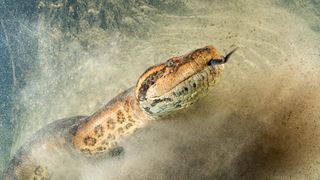Researchers discovered the giant snake’s 47 million-year-old fossils in India.

Scientists in India have discovered the fossilized remains of an ancient snake that may be the largest known serpent to ever live.
The supersized serpent may have measured 50 feet (15 meters) long — surpassing the current record-holder Titanoboa by around 6.5 feet (2 m).
The newly identified species, named Vasuki Indicus, takes its genus name from the mythical king of serpents in Hinduism, which is often depicted wrapped around the neck of one of Hinduism’s main deities, Shiva.
A total of 27 fossilized vertebrae from the enormous snake were unearthed at the Panandhro Lignite Mine in Gujarat state. The fossils date to around 47 million years ago, during the Eocene epoch (56 million to 33.9 million years ago). The authors think the fossils came from a fully grown adult.
The team estimated the serpent’s total body length using the width of the snake’s spine bones and found that V. indicus could have ranged from between 36 feet and 50 feet (11 and 15 m) long, although they acknowledge there may be a possible error associated with their estimate. They published their findings Thursday (April 18) in the journal Scientific Reports.
Related: Snakes are built to evolve at incredible speeds, and scientists aren’t sure why
The researchers used two methods to come up with possible ranges for V. indicus‘ body length. Both used present-day snakes to determine the relationship between the width of a snake’s vertebrae and its length — but they differed in the datasets they used.
window.sliceComponents = window.sliceComponents || {};
externalsScriptLoaded.then(() => {
window.reliablePageLoad.then(() => {
var componentContainer = document.querySelector(“#slice-container-newsletterForm-articleInbodyContent-5JHcKMWMxcVpZ2EYe73VGQ”);
if (componentContainer) {
var data = {“layout”:”inbodyContent”,”header”:”Sign up for the Live Science daily newsletter now”,”tagline”:”Get the worldu2019s most fascinating discoveries delivered straight to your inbox.”,”formFooterText”:”By submitting your information you agree to the Terms & Conditions and Privacy Policy and are aged 16 or over.”,”successMessage”:{“body”:”Thank you for signing up. You will receive a confirmation email shortly.”},”failureMessage”:”There was a problem. Please refresh the page and try again.”,”method”:”POST”,”inputs”:[{“type”:”hidden”,”name”:”NAME”},{“type”:”email”,”name”:”MAIL”,”placeholder”:”Your Email Address”,”required”:true},{“type”:”hidden”,”name”:”NEWSLETTER_CODE”,”value”:”XLS-D”},{“type”:”hidden”,”name”:”LANG”,”value”:”EN”},{“type”:”hidden”,”name”:”SOURCE”,”value”:”60″},{“type”:”hidden”,”name”:”COUNTRY”},{“type”:”checkbox”,”name”:”CONTACT_OTHER_BRANDS”,”label”:{“text”:”Contact me with news and offers from other Future brands”}},{“type”:”checkbox”,”name”:”CONTACT_PARTNERS”,”label”:{“text”:”Receive email from us on behalf of our trusted partners or sponsors”}},{“type”:”submit”,”value”:”Sign me up”,”required”:true}],”endpoint”:”https://newsletter-subscribe.futureplc.com/v2/submission/submit”,”analytics”:[{“analyticsType”:”widgetViewed”}],”ariaLabels”:{}};
var triggerHydrate = function() {
window.sliceComponents.newsletterForm.hydrate(data, componentContainer);
}
if (window.lazyObserveElement) {
window.lazyObserveElement(componentContainer, triggerHydrate);
} else {
triggerHydrate();
}
}
}).catch(err => console.log(‘Hydration Script has failed for newsletterForm-articleInbodyContent-5JHcKMWMxcVpZ2EYe73VGQ Slice’, err));
}).catch(err => console.log(‘Externals script failed to load’, err));
One used data from modern snakes in the Boidae family, which includes boas and pythons and contains the largest snakes alive today. The other dataset used all types of living snakes.
“Vasuki belongs to an extinct family of snakes, distantly related to pythons and anacondas, and so when you’re using existing snakes to estimate body length, there may be uncertainties,” study co-author Debajit Datta, a postdoctoral researcher at the Indian Institute of Technology Roorkee, told Live Science.
The upper end of their estimations would make V. indicus even bigger than Titanoboa cerrejonensis, the biggest snake ever discovered until now, which lived around 60 million years ago and was unearthed in 2002 in northeastern Colombia.
V. indicus belongs to a group of snakes known as Madtsoiidae, which first appeared in the late Cretaceous period (100.5 million to 66 million years ago), in South America, Africa, India, Australia and Southern Europe.
Looking at the sites where ribs would attach to the vertebrae, the researchers think V. indicus had a broad, cylindrical body and mostly lived on land. Aquatic snakes, in comparison, tend to have very flat, streamline bodies.
Due to its large size, the researchers say the snake was likely an ambush predator, subduing its prey by constriction, similar to modern-day anacondas.
The scientists estimate that V. indicus thrived in a warm climate with an average of around 82 degrees Fahrenheit (28 degrees Celsius) — significantly warmer than the present day.
“There are still many things we don’t know about Vasuki. We don’t know about its muscles, how it used them or what it ate,” Datta said.
Sunil Bajpai, study co-author and a vertebrate paleontologist at IIT Roorkee, said the team hopes to have the fossils analyzed for their carbon and oxygen content, which may reveal more about the snake’s diet.

READ MORE
This Guy Got Himself Stung 1,000 Times For Science—Here’s What He Learned
Entomologist Justin O. Schmidt holds the notorious tarantula hawk, one of the only creatures to [...]
Unveiling the Pyrite Meaning: Healing Properties & Everyday Uses
Often mistaken for gold due to its metallic luster, pyrite has a playful nickname but [...]
5 Tips for Selling Your Used Books
Is it time to take a good look at your book collection? Dave Nagel/Photographer’s Choice/Getty [...]
Enhancing the antimicrobial activity of silver nanoparticles against pathogens by using tea extracts
The characterization of the synthesized TeaNPs: SEM pictures of (A) B-TeaNPs, (B) G-TeaNPs, and (C) [...]
Mob Boss John Gotti Never Lived Up to His ‘Teflon Don’ Nickname
Reputed Gambino crime boss John Gotti is leaving court with his lawyers during his 1990 [...]
Shunning the Suez: Tankers Take the Long Route to Save Cash
A cargo ship navigates in the Suez Canal past the port authority building of Port [...]
Graphene can be used to detect COVID-19 quickly, accurately
An illustration of the graphene-based COVID-19 spike protein detection process developed at UIC. The white [...]
Must the Molecules of Life Always be Left-Handed or Right-Handed?
Must all molecules of life be handed? agsandrew / iStock One of the strangest aspects [...]